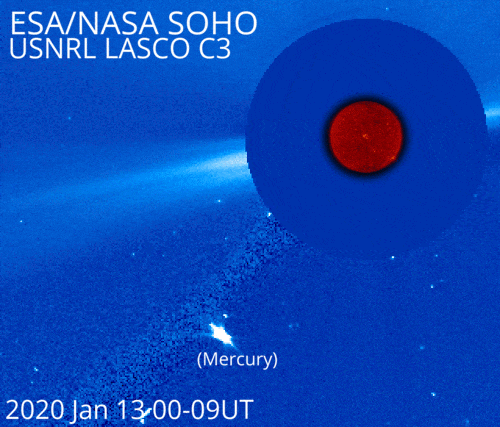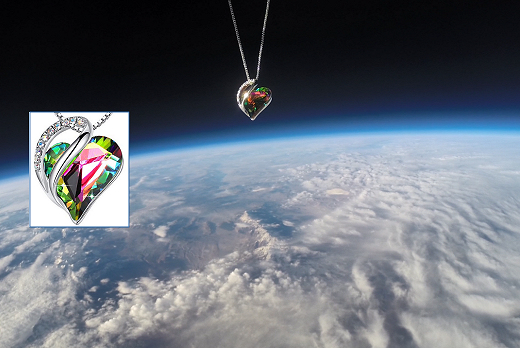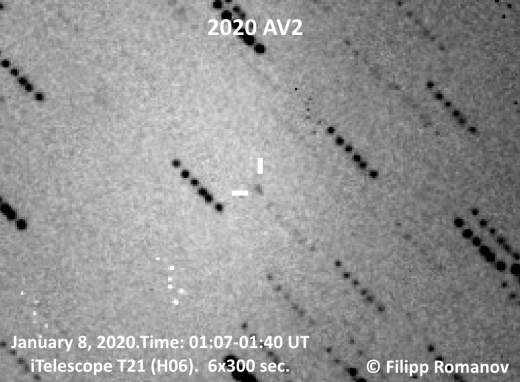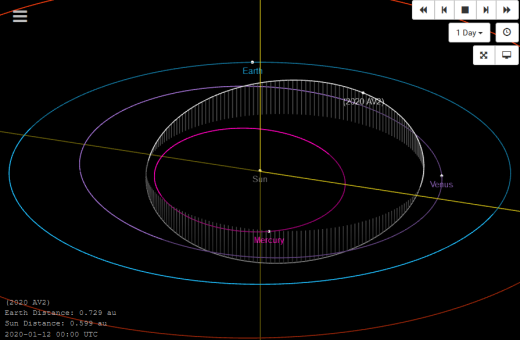Marianne’s Arctic tours: Operating in small groups of 7 to 14 persons--all needs supplied for safety, comfort and pleasure. Night & day photography or non-photographic landscape - wildlife tours. Click for details! | | |
SOLAR WIND, INCOMING: Earth's magnetic field could feel a bump in pressure on Jan. 14th and 15th when a complex stream of solar wind reaches our planet. The gaseous material is a mixture of exhaust from two and perhaps three holes in the sun's atmosphere. No geomagnetic storms are expected, but Arctic sky watchers will likely see a surge of auroras when the solar wind arrives. Aurora alerts: SMS Text.
THE SUN SWALLOWS A COMET: A new comet was discovered today, and it's already history. "The first comet discovery of the decade goes to... SOHO!" reports Karl Battams of the Naval Research Lab in Washington DC. During the early hours of Jan. 13th, coronagraphs onboard SOHO (the Solar and Heliospheric Observatory) spotted the tiny comet plunging into the sun, where it rapidly evaporated:

SOHO is the most prolific comet hunter in history. "It's actually quite unusual that it has taken 13 days for SOHO to find a comet," notes Battams. "This is the furthest we've gone into a new calendar year without a discovery since 2008. We're closing in on 3,900 comets discovered, and should comfortably pass 4,000 sometime this year!"
The doomed comet, R.I.P., was a member of the Kreutz family. Kreutz sungrazers are fragments from the breakup of a single giant comet many centuries ago. They get their name from 19th century German astronomer Heinrich Kreutz, who studied them in detail. Hundreds of Kreutz fragments pass by the sun and disintegrate every year--a fact that has helped SOHO pad its totals. In fact, the second comet of the new decade will probably be a Kreutz sungrazer, too. Stay tuned :)
Note: When SOHO discovers a comet, it always has help. A human watching coronagraph images is required to spot the sungrazer. In this case, says Battams, "The comet was noticed by Worachate Boonplod (Thailand) - one of our most successful amateur comet hunters."
Realtime Spaceweather Photo Gallery
Free: Spaceweather.com Newsletter
INFINITY PENDANT FOR VALENTINE'S DAY: Valentine's Day is one month away. Nothing says "I Love You" like an Infinity Pendant from the edge of space. On Jan. 8, 2020, the students of Earth to Sky Calculus launched a cosmic ray balloon. This authentic Swarovski crystal pendant hitched a ride, traveling 113,209 feet above the Sierra Nevada mountains of central California

You can have it for $169.95. The students are selling these pendants to support their cosmic ray ballooning program. The glittering heart-shaped crystal is wrapped in a silver-embossed infinity clasp, symbolizing unending love. Each one comes with a romantic card showing the pendant in flight and telling the story of its journey to the edge of space and back again.
Far Out Gifts: Earth to Sky Store
All sales support hands-on STEM education
A NEW KIND OF ASTEROID: Between Mars and Jupiter lies the Asteroid Belt where millions of space rocks orbit the sun. It's where asteroids are supposed to be. However, newfound asteroid 2020 AV2 is out of place: It circles the sun entirely inside the orbit of Venus. Russian amateur astronomer Filipp Romanov (Филипп Романов) photographed 2020 AV2 on Jan. 8th:

"Until 2020, no known asteroids had orbits contained within that of Venus," says Romanov. "On 4 January 2020, the Zwicky Transient Facility (ZTF) discovered this one, and I was able to photograph it only 4 days later using a remotely-controlled iTelescope in New Mexico."
There's already a small class of asteroids called "Atiras" (named after the first one confirmed in 2003) that have orbits entirely inside Earth. Fewer than 2 dozen have been found. The discovery of 2020 AV2 takes things a step closer to the sun. Astronomers are tentatively calling its class "Vatiras"--a mashup of Venus and Atiras.
Click to view an interactive orbit of 2020 AV2 from the Jet Propulsion Laboratory:

Researchers don't know much about the population of space rocks in the innermost solar system. The sun's glare makes such objects very hard to find. The Zwicky Transient Facility is actively surveying the twilight sky, looking for more asteroids like 2020 AV2. Perhaps the inner solar system is where space rocks are supposed to be, too....
Realtime Aurora Photo Gallery
Free: Spaceweather.com Newsletter
Every night, a network of
NASA all-sky cameras scans the skies above the United States for meteoritic fireballs. Automated software maintained by NASA's Meteoroid Environment Office calculates their orbits, velocity, penetration depth in Earth's atmosphere and many other characteristics. Daily results are presented here on Spaceweather.com.
On Jan. 13, 2020, the network reported 10 fireballs.
(9 sporadics, 1 beta Sextantid)

In this diagram of the inner solar system, all of the fireball orbits intersect at a single point--Earth. The orbits are color-coded by velocity, from slow (red) to fast (blue). [Larger image] [movies]
Potentially Hazardous Asteroids (
PHAs) are space rocks larger than approximately 100m that can come closer to Earth than 0.05 AU. None of the known PHAs is on a collision course with our planet, although astronomers are finding
new ones all the time.
On January 13, 2020 there were 2018 potentially hazardous asteroids.
 |
Recent & Upcoming Earth-asteroid encounters: | Asteroid | Date(UT) | Miss Distance | Velocity (km/s) | Diameter (m) |
| 2020 AR1 | 2020-Jan-08 | 6.9 LD | 9.6 | 13 |
| 2020 AT1 | 2020-Jan-09 | 2.5 LD | 6.2 | 11 |
| 2019 YV | 2020-Jan-10 | 17.3 LD | 4.5 | 68 |
| 2020 AL2 | 2020-Jan-10 | 6.2 LD | 24.8 | 27 |
| 2019 YF4 | 2020-Jan-10 | 3.7 LD | 2.9 | 14 |
| 2019 UO | 2020-Jan-10 | 11.8 LD | 9.4 | 339 |
| 2019 WC5 | 2020-Jan-11 | 6.4 LD | 13 | 112 |
| 2019 YV5 | 2020-Jan-11 | 16.8 LD | 13.9 | 47 |
| 2020 AO1 | 2020-Jan-12 | 8.5 LD | 17.7 | 65 |
| 2020 AB2 | 2020-Jan-12 | 3.8 LD | 8 | 14 |
| 2020 AE | 2020-Jan-13 | 11.7 LD | 6.8 | 26 |
| 2020 AX2 | 2020-Jan-13 | 10 LD | 6.8 | 28 |
| 2020 AS1 | 2020-Jan-13 | 15.8 LD | 5.7 | 16 |
| 2020 AE1 | 2020-Jan-13 | 6.6 LD | 4.2 | 11 |
| 2020 AO | 2020-Jan-14 | 9.3 LD | 19.5 | 49 |
| 2011 EP51 | 2020-Jan-15 | 19.6 LD | 7.1 | 32 |
| 2017 RZ15 | 2020-Jan-15 | 12.1 LD | 7.4 | 14 |
| 2020 AZ1 | 2020-Jan-16 | 8.3 LD | 4 | 17 |
| 2019 YD3 | 2020-Jan-16 | 6.9 LD | 4.8 | 22 |
| 2010 AE30 | 2020-Jan-17 | 11.9 LD | 12.3 | 68 |
| 2019 YG1 | 2020-Jan-17 | 17.5 LD | 4.5 | 32 |
| 2019 YQ3 | 2020-Jan-17 | 18.2 LD | 3.1 | 19 |
| 2020 AD1 | 2020-Jan-17 | 9.1 LD | 4.5 | 20 |
| 2020 AH1 | 2020-Jan-18 | 15.9 LD | 8 | 45 |
| 2009 BH2 | 2020-Jan-18 | 14.6 LD | 17.9 | 118 |
| 2019 YA5 | 2020-Jan-19 | 11.7 LD | 5.2 | 22 |
| 2020 AQ1 | 2020-Jan-20 | 10.6 LD | 27.6 | 135 |
| 2013 DU | 2020-Jan-20 | 14.9 LD | 6.4 | 56 |
| 2019 TF2 | 2020-Jan-23 | 16.2 LD | 1.6 | 19 |
| 2018 BM5 | 2020-Jan-23 | 13.1 LD | 8.6 | 12 |
| 2018 AL12 | 2020-Jan-30 | 18.2 LD | 17.7 | 39 |
| 2017 AE5 | 2020-Feb-01 | 13.6 LD | 9 | 123 |
| 2018 BU1 | 2020-Feb-02 | 19.4 LD | 10 | 41 |
| 163373 | 2020-Feb-15 | 15.1 LD | 15.2 | 589 |
| 2018 CW2 | 2020-Feb-17 | 6 LD | 10.2 | 28 |
| 2019 BE5 | 2020-Feb-20 | 13.9 LD | 14.8 | 34 |
| 2011 DR | 2020-Feb-23 | 14.7 LD | 5.8 | 25 |
| 2016 CO246 | 2020-Feb-23 | 18.4 LD | 5.9 | 25 |
| 2012 DS30 | 2020-Feb-26 | 12.3 LD | 5.4 | 22 |
| 2015 BK509 | 2020-Feb-28 | 18.3 LD | 12.5 | 118 |
| 2017 BM123 | 2020-Mar-01 | 10.5 LD | 8.1 | 65 |
| 2018 RF6 | 2020-Mar-10 | 11.2 LD | 12.6 | 36 |
| 2008 UB95 | 2020-Mar-11 | 18.5 LD | 7.6 | 41 |
Notes: LD means "Lunar Distance." 1 LD = 384,401 km, the distance between Earth and the Moon. 1 LD also equals 0.00256 AU. MAG is the visual magnitude of the asteroid on the date of closest approach. | | Cosmic Rays in the Atmosphere |
SOMETHING NEW! We have developed a new predictive model of aviation radiation. It's called E-RAD--short for Empirical RADiation model. We are constantly flying radiation sensors onboard airplanes over the US and and around the world, so far collecting more than 22,000 gps-tagged radiation measurements. Using this unique dataset, we can predict the dosage on any flight over the USA with an error no worse than 15%.
E-RAD lets us do something new: Every day we monitor approximately 1400 flights criss-crossing the 10 busiest routes in the continental USA. Typically, this includes more than 80,000 passengers per day. E-RAD calculates the radiation exposure for every single flight.
The Hot Flights Table is a daily summary of these calculations. It shows the 5 charter flights with the highest dose rates; the 5 commercial flights with the highest dose rates; 5 commercial flights with near-average dose rates; and the 5 commercial flights with the lowest dose rates. Passengers typically experience dose rates that are 20 to 70 times higher than natural radiation at sea level.
To measure radiation on airplanes, we use the same sensors we fly to the stratosphere onboard Earth to Sky Calculus cosmic ray balloons: neutron bubble chambers and X-ray/gamma-ray Geiger tubes sensitive to energies between 10 keV and 20 MeV. These energies span the range of medical X-ray machines and airport security scanners.
Column definitions: (1) The flight number; (2) The maximum dose rate during the flight, expressed in units of natural radiation at sea level; (3) The maximum altitude of the plane in feet above sea level; (4) Departure city; (5) Arrival city; (6) Duration of the flight.
SPACE WEATHER BALLOON DATA: Approximately once a week, Spaceweather.com and the students of Earth to Sky Calculus fly space weather balloons to the stratosphere over California. These balloons are equipped with radiation sensors that detect cosmic rays, a surprisingly "down to Earth" form of space weather. Cosmic rays can seed clouds, trigger lightning, and penetrate commercial airplanes. Furthermore, there are studies ( #1, #2, #3, #4) linking cosmic rays with cardiac arrhythmias and sudden cardiac death in the general population. Our latest measurements show that cosmic rays are intensifying, with an increase of more than 18% since 2015:

The data points in the graph above correspond to the peak of the Reneger-Pfotzer maximum, which lies about 67,000 feet above central California. When cosmic rays crash into Earth's atmosphere, they produce a spray of secondary particles that is most intense at the entrance to the stratosphere. Physicists Eric Reneger and Georg Pfotzer discovered the maximum using balloons in the 1930s and it is what we are measuring today.
En route to the stratosphere, our sensors also pass through aviation altitudes:

In this plot, dose rates are expessed as multiples of sea level. For instance, we see that boarding a plane that flies at 25,000 feet exposes passengers to dose rates ~10x higher than sea level. At 40,000 feet, the multiplier is closer to 50x.
The radiation sensors onboard our helium balloons detect X-rays and gamma-rays in the energy range 10 keV to 20 MeV. These energies span the range of medical X-ray machines and airport security scanners.
Why are cosmic rays intensifying? The main reason is the sun. Solar storm clouds such as coronal mass ejections (CMEs) sweep aside cosmic rays when they pass by Earth. During Solar Maximum, CMEs are abundant and cosmic rays are held at bay. Now, however, the solar cycle is swinging toward Solar Minimum, allowing cosmic rays to return. Another reason could be the weakening of Earth's magnetic field, which helps protect us from deep-space radiation.
| | The official U.S. government space weather bureau |
| | The first place to look for information about sundogs, pillars, rainbows and related phenomena. |
| | Researchers call it a "Hubble for the sun." SDO is the most advanced solar observatory ever. |
| | 3D views of the sun from NASA's Solar and Terrestrial Relations Observatory |
| | Realtime and archival images of the Sun from SOHO. |
| | from the NOAA Space Environment Center |
| | fun to read, but should be taken with a grain of salt! Forecasts looking ahead more than a few days are often wrong. |
| | from the NOAA Space Environment Center |
| | the underlying science of space weather |
 | To find reviews of new online casino sites in the UK try The Casino DB where there are hundreds of online casino reviews complete with bonuses and ratings. Get a bonus when playing at a new casino in the UK. The Genie got you covered! Looking for a new online casino? Try Casimpo the new site dedicated to making online casino simple and easy for all. |
| | These links help Spaceweather.com stay online. Thank you to our supporters! |
| | | | | | |

